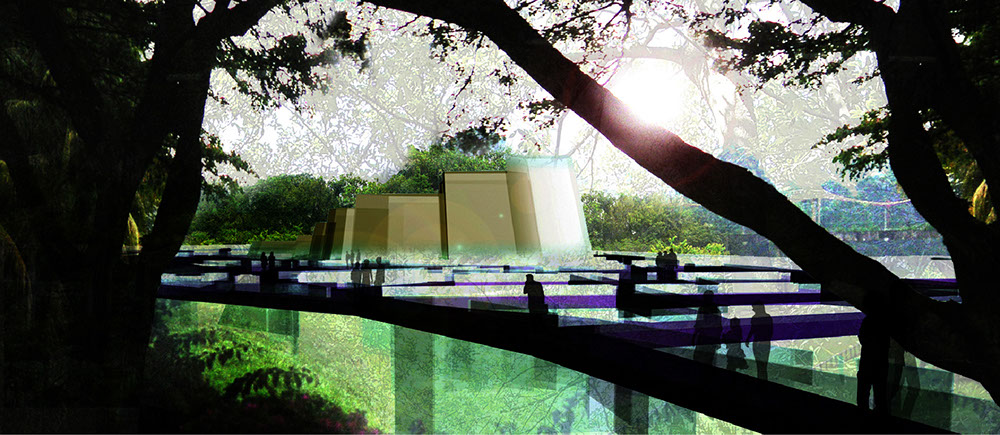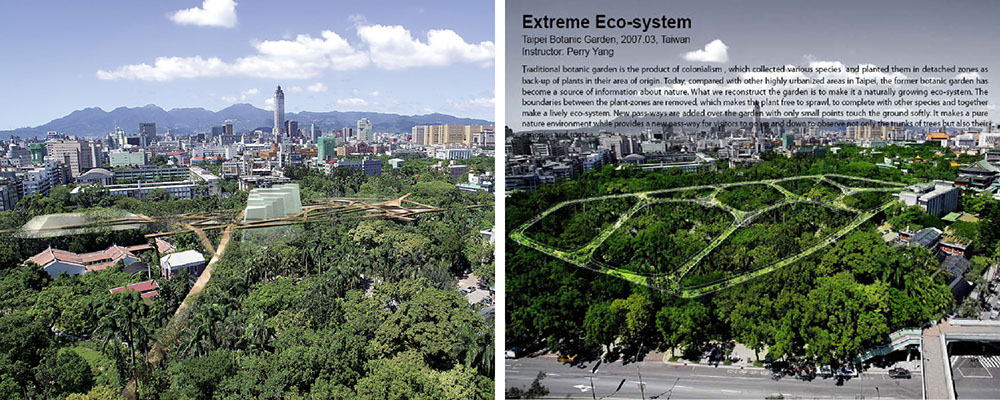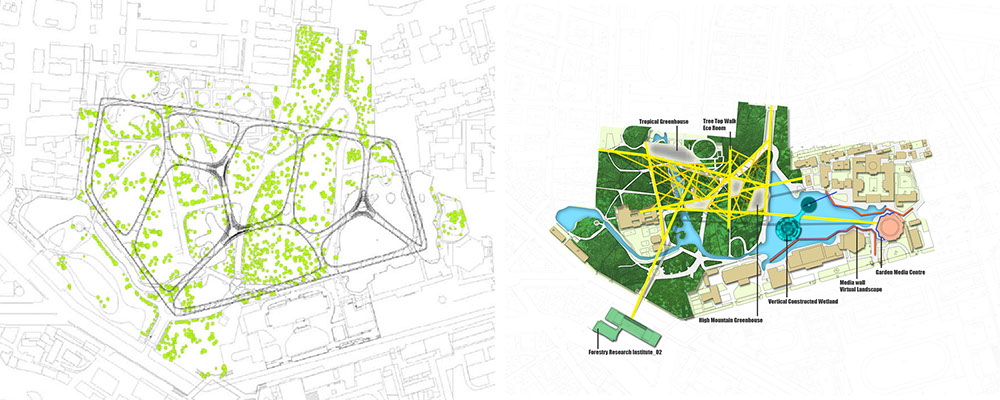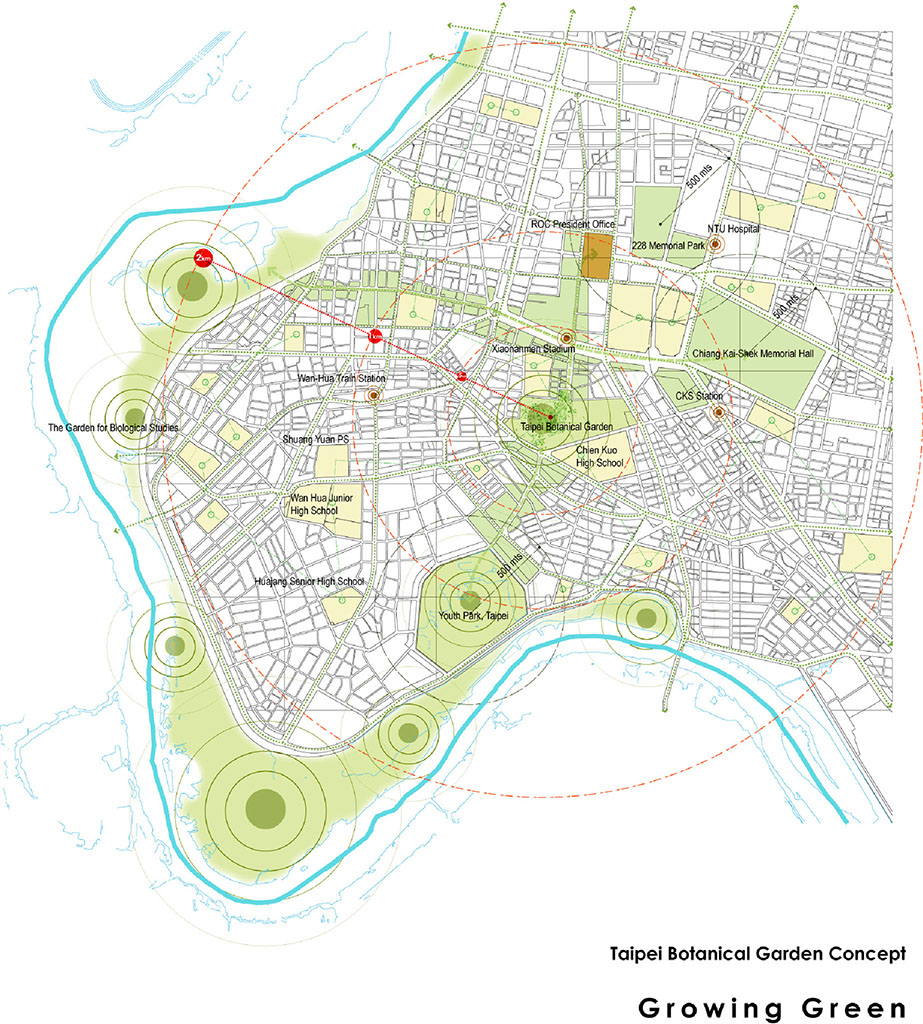TAIPEI/2005
Taipei Botanic Garden: Symbiotic Nature

Design Team:
Perry Yang, Woon Chung Yen, Anandan Karunakaran, Melissa Tan, Cheng Sin Mei, Sam Wei Yee, Meutia Chaerani, Wu Hailong
Collaborators:
Sensing Places: Flavia Sparacino (Digital media and Interactive design); TKC: Ling-Ru Cheng (Landscape Architect); Tan Beng Kiang (Architect); Aleck Yang (Botanic Consultant); Ong Boon Lay (Tropical Architecture and Plant); Chu-Jo Hsia(Historic Conservation Consultant)
Awards:
1st Prize
The Taipei Botanical Garden is a setting with a century-long landscape history and archeological sites over thousands years. The time dimension and its centrality make the garden renovation project highly symbolic and full of meanings. The design is generated by three questions:
1. How do we regenerate the structure and flow of nature in an intensive urban environment? How do we deal with the botanic garden, a valuable landscape patch in the core area of Taipei inner city?
2. To become the center of national botanic garden network, the site is too small to accommodate more programs, activities, plants and eco-systems. Instead of preserving the existing 1,500 species on site, how can we increase the capacity of the garden? How do we “grow” the nature?
3. The tradition way of learning the nature in botanic garden (or learning the history in museum) is based on the mode of “one label, one plant or one object” learning pattern. How do we go beyond the 20th century’s way of reading garden, and create an innovative way of environmental learning?
The three key dimensions, Ecocity catalyst, Growing garden and Digital learning, formulate the structure of the Botanic Garden. There are three propositions and the six design issues taken for revitalizing the Taipei Botanic Garden for the new century:
1. Ecocity catalyst – Taipei Botanic Gadern can become a catalyst of large-scale eco-city development and the city’s ecological transformation by enriching existing garden as landscape mosaics composed various ecological patches and through increasing the carrying capacity of the setting and multiplying ecological interfaces and surfaces. The garden will serve as the ecological generator as a public space of the district. The effects of green corridor and the making of ecological infrastructure will create a new public space that connects parks, community, cultural facilities and schools. The application of green floor area ratio guidelines will encourage ecological approach to urban redevelopment of the surrounding areas.
2. Growing nature – growing the nature by creating eco-infrastructure, symbiotic relationship and innovative management & technology. The garden is not a static entity and it grows dynamically. The garden is a vehicle to enhance the capacity of an ecosystem within an urban area, and hence can increase the ecological efficiency and improve the bio-diversity within the garden itself. The design of multiple-level treetop walk concourses enhances new experiences approach nature with novel perspectives. The spatial framework allows new nature to grow in the mat-like infrastructure. Symbiotic design is a key to organizing the ecological functions of the space by connecting water, material, nutrient and energy flows . among various sub-ecosystems, including Temperate, High Mountain, Tropic, Aquatic/Wetland ecosystems, represents a diversity of the whole Taiwan island ecosystems.
3. Interactive learning – Park as museum, museum as park and the digital environmental learning. The botanic garden needs to serve an important educational role and tell its visitors about the variety, importance, beauty of the ecosystems. Until now the museographic approach to Botanical Museums has been an encyclopedic one, which strongly relies on text labeling and extensive cataloguing. The garden will offer new ways of environmental learning of ecosystems, by moving away from a conventional “one label, one plant” reading to interactive approach. We extending it to its digital dimension and make it an infinite garden through articulating media technology into the garden exhibit. The media technology will enable augmentation of the flora to simulate the experience that transcends scale and time boundaries. Leveraging on the time and historic dimension of the site, the idea of “park as museum” and “museum as park” are coined in the making of natural and historical processes visible by integrating historical buildings, archeological sites with the garden.



